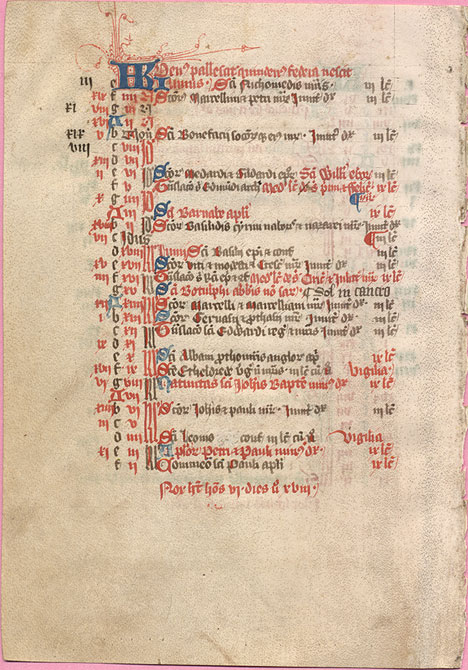
Latin Breviary from the Diocese of Norwich, East Anglia15th Cent.
Collecting fragments from eBay Sellers

|
Dismembered Manuscripts Latin Breviary from the Diocese of Norwich, East Anglia15th Cent. Collecting fragments from eBay Sellers |
 |  |
|
|
Kalendar : Month of June
Numerous English Saints, some graded "non Sarum". [sed Norw'(icis)] The abbreviation pp for "Pape" erased (after 1537) Private Collection in Britain |
Cutting up manuscripts for ... profit
(AMARC Newsletter no. 42, 2004 - Exerpt of article by Peter Kidd)
Online auction companies such as eBay are enabling dealers to make quick returns by breaking up manuscripts and selling the leaves individually. This is not a new phenomenon, but the rate at which it happens has accelerated recently. The commercial benefits of the practice are explained by Christopher de Hamel in his Cutting Up Manuscripts for Pleasure and
Profit (Charlottesville, 1996), p. 19: "You buy a manuscript for a thousand dollars (for example). You break it in two and each half is worth $900. You tear it in half again and each quarter is worth $800; you split it again and each eighth is worth $750; and so on".
He goes on to give an example of a manuscript sold at auction for $12,000 in October 1980, which was then "worth" $190,800 shortly thereafter when cut into single leaves retailing at prices from $350 (text leaves) to $1750 (leaves with historiated initials).
What is perhaps troubling about the recent trend is that while many dealers would not break up a complete manuscript (limiting themselves to more or less imperfect ones), especially one in an old or fine binding, other dealers do not have such scruples. And while most might limit themselves to breaking-up textually unimportant manuscripts such as mass-produced late 15th-century Rouen books of hours - though perhaps the only reason for this is that they can be bought relatively inexpensively, and have a relatively high proportion of commercially preferable pages with decoration - a number of more interesting manuscripts have been recently dismembered.
A good example is an apparently complete illuminated Breviary sold for $7,050 (including buyer's premium) at Butterfield's in San Francisco on Tuesday, 14 Oct. 2003, as lot 5005 (mentioned prior to the sale in AMARC
Newsletter no. 41). It was catalogued as Italian, Use of Rome, and dated c. 1265 on account of a misunderstood flyleaf inscription. Single leaves of the book were being offered on eBay by the Friday of the same week - perhaps even before the buyer had taken delivery of the book - accompanied by photographs in which the manuscript was not yet disbound.
An email to the vendor, enquiring about the possibility of keeping the volume intact, received the following reply:
"Thank you for your email & interest in our manuscript! It is a beauty.
This manuscript has not been taken apart yet. It consists of 261 leaves, beautiful binding and is US $15,000 plus shipping."
Although it is English, not Italian as stated, it is also not 13th-century, and therefore probably not "worth" $15,000 at current market prices.
Within a few more days the book was broken and being sold, sometimes one leaf at a time, sometimes in groups of eight or ten consecutive leaves.
The six-leaf calendar was sold as single leaves, three going to a buyer in the USA, the others to a collector in the UK. Erik Drigsdahl has examined images of the calendar and found that it contains the feast of the Dedication of Norwich cathedral: thus, instead of being an ordinary Breviary of the Use of Sarum, it is (or was) potentially of much greater liturgical, historical, and art-historical interest. Clearly some dealers have very little knowledge about the manuscripts they buy and dismember; it is perhaps only a matter of time before something truly important is butchered in this way.
Attempting to stem the tide would be futile. But if one believes that the practice of deliberately dismembering manuscripts for sale on eBay is a cause for regret, what should be done?
For the student of manuscripts, online auctions have an interesting side-effect: anyone minded to do so can collect scores of the often high-quality photographs/scans that promote the sale of each leaf which, in theory, would allow the virtual reconstruction of the book and the creation of a complete digital facsimile. (In practice, dealers often consign groups of leaves to a variety of auction houses in the UK, USA, and Europe - including the auction house from which the intact book was acquired - where they are less likely to be reproduced in a catalogue). Perhaps what are needed are individuals willing to take it upon themselves to collect and archive such images, or institutions willing to sponsor such work.
Another: 'Benedictine Breviary 1380' - Breviary In Latin (15th c.)
xxxff. 2 cols. of 32 lines.
Sold Hartung 2003 (?). Dismembered and sold by Tuscany Books 2003-2005. Due to the poor and miserable quality of the pictures shown can it easily be taken for the previous item, which seems also to have happened for the seller himself.